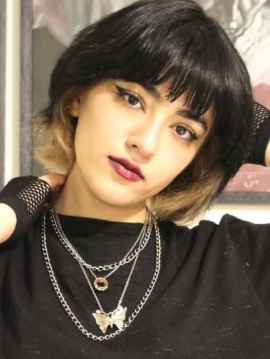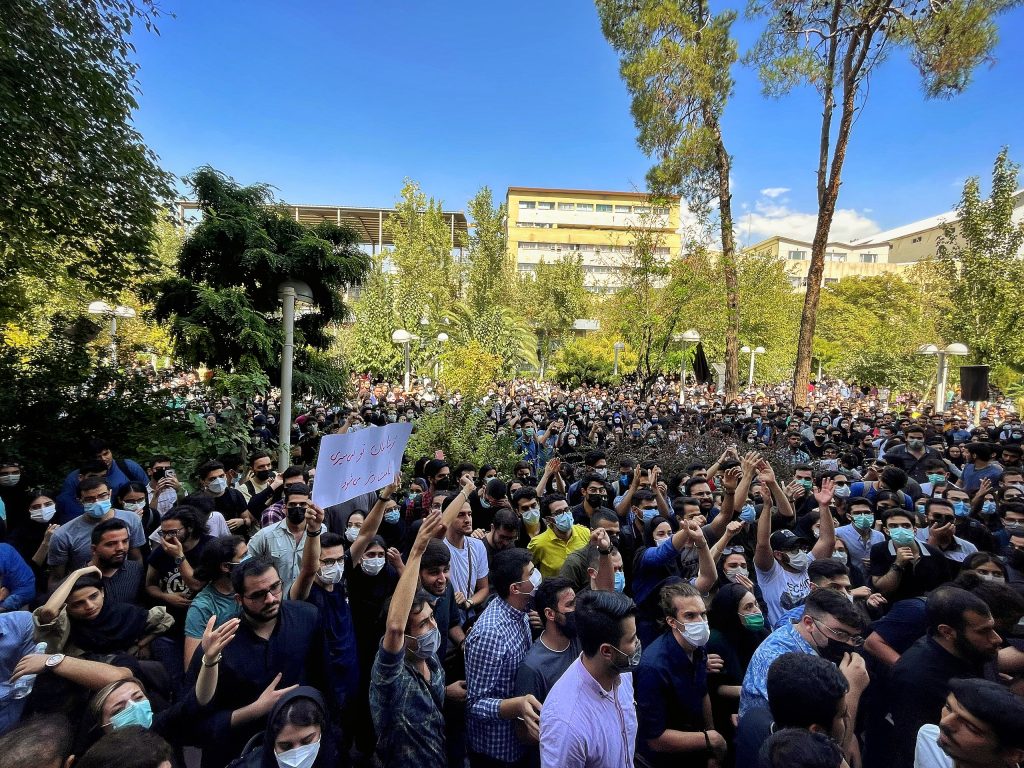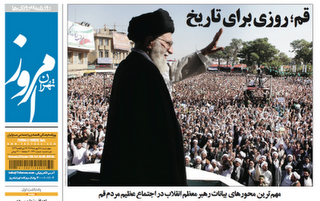Index relies entirely on the support of donors and readers to do its work.
Help us keep amplifying censored voices today.
The death in custody of 22-year-old Mahsa Amini in Iran following her arrest by the “morality police” has sparked widespread protests across the country, with women taking a prominent role in demonstrating against their unequal treatment in the country. The Iranian regime, led by Ayatollah Khamenei, has responded with deadly violence.
Since Amini’s death on 16 September, precipitated by her arrest for not wearing the hijab correctly, at least 185 people, including at least 19 children, have been killed in the nationwide protests across Iran, according to the Center for Human Rights in Iran (CHRI). The deaths of several young women involved in the protests has led to a growing chorus of outrage, both within the country and internationally.
Among the dead is Sarina Esmailzadeh, a 16-year-old girl who was killed following protests on 22 September in Mehrshahr, just outside Tehran, reportedly due to repeated baton blows by security forces. Authorities have aired “so-called” confessions by alleged family members stating that her death was suicide, which have been called into question.
 Nika Shakarami (right) has also died, allegedly at the hands of the Iranian security forces, after she was pictured burning her hijab. The 17-year-old disappeared for nine days before her badly beaten body was identified by her family in a morgue.
Nika Shakarami (right) has also died, allegedly at the hands of the Iranian security forces, after she was pictured burning her hijab. The 17-year-old disappeared for nine days before her badly beaten body was identified by her family in a morgue.
Women human rights defenders and journalists are being targeted. Femena reports that women’s rights activist Narges Hosseini, one of the “Girls of Revolution Street”, who protested back in 2017 and 2018 about the compulsory hijab, was arrested on 22 September in Kashan in central Iran. Four years ago, she spent three months in prison on charges of “encouraging prostitution” and “non-observance of hijab”.
CHRI has also reported on the arrest of Niloufar Hamedi, a well-known journalist who first revealed the circumstances surrounding Mahsa Amini’s death that same say. Hamedi has been placed in solitary confinement in the notorious Evin prison.
Others who have been detained include journalist and woman human rights defender, Elaheh Mohammadi, Kurdish writer and filmmaker Mozhgan Kavusi and photojournalist Yalda Moayeri, according to Femena.
Golrokh Ebrahimi Iraeei, an Index contributor who was only released from prison in May 2022 after being imprisoned in 2014 on charges of insulting the Supreme Leader and spreading propaganda against the state, has also been rearrested.
The attacks and arrests have so far not managed to silence women, who continue to protest. According to the BBC World Service’s Rana Rahimpour women are walking the streets of Tehran with no hijab and cars are honking their support. School girls have also joined the protests. Social media posts that have gone viral show them going without a hijab and making rude gestures to and removing and covering the images of Supreme Leader Ayatollah Khamenei in their classrooms.
On 9 October, teenage girls in the city of Arak, southwest of capital Tehran, marched in protest chanting “death to the dictator”, before they were fired on with rubber bullets and tear gas by riot police.
Protests have also sprung up at universities across the country. Shots were fired indiscriminately by security forces at a protest at Tehran’s Sharif University on 8 October, according to CHRI. Students at the city’s University of Art held a demonstration on 10 October where they congregated to spell out the word “blood”. The same day, female students at the Polytechnic University chanted, “Tell my mother she no longer has a daughter” – a shocking reference to the fate that could befall the students for daring to protest.

Students of Amir Kabir university protest against the hijab. Photo: Darafsh Kaviyani
There are signs that support for the protests is spreading more widely. Oil workers in Iran, including port workers in Asaluyeh and refinery workers in Abadan, are striking in support of the protests. This could be significant as such protests have not been seen since the 1979 revolution.
The city of Sanandaj in Kurdistan has become the frontline of the protests and the regime has cracked down brutally, leading some to call the city a “war zone”. The CHRI reports that at least four people have been killed and more than 100 injured on 9 October. The government has deployed forces from outside the region in the city.
News that has emerged from Iran has made it out despite widespread internet and mobile network shutdowns in the country. NetBlocks has reported that the internet national mobile disruptions were in place once again and the internet had been cut in Sanandaj. Speaking to an Index correspondent over the phone from his home city of Sari in the north of Iran, the censored musician Mehdi Rajabian said: “It has become very difficult for me to access the free internet and the speeds of the platforms are very slow and blocked. I have to connect with a filter breaker and many times the filter breakers don’t work. Our communication is very slow.”
Such restrictions mean that the number of those killed, injured or detained is likely to be much higher.
There are signs that Iranians are increasingly looking to virtual private networks (VPNs) to help them circumvent the country’s internet broad censorship. Research by the VPN tracker Top10VPN.com shows that downloads of VPNs in Iran were 30 times higher at the end of September than in the previous 28 days and that demand for the services remains significantly heightened.
CHRI’s executive director Hadi Ghaemi feels that the situation is likely to worsen as Khamenei’s rule comes under growing pressure.
“The ruthless killings of civilians by security forces in Kurdistan Province, on the heels of the massacre in Baluchestan Province, are likely preludes to severe state violence to come,” said Ghaemi in a statement about the protests.
He said, “World leaders must move beyond statements of condemnation to collective action through an international front signalling to the government in Iran that the international community will not look the other way and conduct business as usual while it slaughters unarmed civilians.”
In response, Khamenei has said foreign states are responsible for driving the women’s protests. With support growing fast, he may soon no longer be able to lay the blame outside Iran’s borders.

“For the preservation of your newspaper and the health of its managing directors, pay careful attention to the following…” Replica front pages inspire a fake directive from the regime. Negar Esfandiary reports
On Friday, browsing an Iranian website 30 mail, I couldn’t help but notice a repeated image of Ayatollah Khamenei standing before a mammoth crowd. At first I thought it was a online freeze but at a second glance the familiar titles of Iran’s newspapers became apparent. Each was faithfully reporting the Supreme Leader’s trip to Qom, the holy city southwest of Tehran. One front page was barely distinguishable from another.
The website Neda Sabz Azadi took advantage of this comic-tragic state of affairs. Under the headline “Bring a logo, take a newspaper” they spoofed a directive from the “Ministry of Culture’s Press Deputy”.
This timely joke coincided with the day that Reporters Without Borders published its annual Press Freedom Index. Iran classified rock bottom at number 175 of 178 countries.
With the identikit front pages there for all to see, the truth was probably not so far from this five point “leaked” missive. Fiction based on fact from a media well-versed in the language of an authoritarian state. Translation of the “directive” below.
On the occasion of the extremely important trip of our leader — but pertinent to all Muslims in human history — to the holy city of Qom the most important city in the world, photographs and suggested headlines are attached.
For the preservation of the status of your newspaper and the health of its managing directors, pay careful attention to the following points:
1. One photo for half front page usage with at least 75 per cent coverage and up to 150 per cent. Note: Newspapers who have received warnings should make every effort to show their goodwill by printing the photograph at 90 per cent. Other more insider newspapers know what to do.
2.The use of at least one of the headlines below is obligatory:
* Vaccination by ‘88 intrigue (insider papers to all use this)
[Implying that the people were immunised and united after the 2009 post-election uprising.
* Ghadir-e-Ghom (only for use by the most insider papers)
[Alluding to a place of pilgrimage (of the same name) in Saudi Arabia where the prophet Mohammad spoke.]
- * The uprising of the people of Qom
- * National unity
- * A historical day
- * Sunshine of revolution in Qom
- * Dealing with sanctions3. This applies to all economic, sport, cultural, and scientific newspapers, magazines and weeklys published this week, next week and in the subsequent two weeks.4. On Wednesday your headline must be set at three times its usual size. We will pay your paper subsidies.
5. Publications that do not have the financial means or printing facilities should provide their national identity card and newspaper logo to the press office and we will print it for them.
Iran’s supreme leader and cleric, Ayatollah Khamenei released a statement claiming that learning and teaching music are “not compatible” with Islamic laws and values. According to Fars news agency, he said: “It’s better that our dear youth spend their valuable time in learning science and essential and useful skills and fill their time with sport and healthy recreations instead of music.” Khamenei made the comments after one of his followers asked him for advice on taking up music lessons. When Khamenei was president, he banned western-style music.
Ayatollah Ali Khamenei has said that music is incompatible with the Iranian revolution, and hence he is not available to dj at weddings, baptisms or bar mitzvahs. Shame.
In response to a question from a student, the “supreme leader” commented: “Although music is halal, promoting and teaching it is not compatible with the highest values of the sacred regime of the Islamic Republic.”
Which makes now probably as good a time as any to tell you that the next issue of Index on Censorship magazine will focus on censorship of music and musicians.
From Iran, we’ve got an article on the Tehran indie scene by Negar Shaghaghi of Take It Easy, Hospital (stars of No One Knows About Persian Cats), and an interview with electro-rock singer Maral Afsharian.
In the meantime, if the Ayatollah doesn’t like music, I’d imagine he hates this:
Different Ayatollah, but still…